 Asakusa Jinja (浅草神社) is a Shinto shrine in Tokyo, forming, together with adjoning Sensoji Temple, the central component of the nostalgic shitamachi atmosphere of the Asakusa district. For details about this shrine, see the article on Sensoji Temple & Asakusa Shrine.
Asakusa Jinja (浅草神社) is a Shinto shrine in Tokyo, forming, together with adjoning Sensoji Temple, the central component of the nostalgic shitamachi atmosphere of the Asakusa district. For details about this shrine, see the article on Sensoji Temple & Asakusa Shrine.
The Sanja Matsuri (三社祭), which is one of the most notable traditional events in Tokyo, is the annual grand festival of Asakusa Shrine -- a Shinto shrine usually holds one or two grand festival(s) a year -- and is held from Friday through Sunday closest to May 17th, attracting about 1.5 million people during this period.
The Sanja Matsuri is said to have started in 1312, and until in 1872 the newly erected government of that time forcefully separated Buddhism and Shintoism, leading to the separation of Sensoji Temple and Asakusa Shrine as well, it was held together with the Honzon-jigen'e of Sensoji Temple on March 18. In those days, Asakusa Jinja was called Sanja Gongen, so the term Sanja comes from here. Sanja means "three shrines," indicating the three divinities enshrined at Asakusa Shrine. (A Gongen is a Buddhism-influenced title given to native Japanese gods.) These three deities were legendary commoners who were involved in the foundation of Sensoji Temple back in March 18th of 628, and the Honzon-jigen'e is a ceremony to comemorate the foundation of the temple.
Schedule of Sanja Matsuri
Every year, there's a Dai-gyoretsu procession on Friday, parades of some 100 communities' mikoshi on Saturday, and processions of three shrine's mikoshi on Sunday. Sunday is the most important day, and the Miyadashi (starting of the processions) of that day is especially regarded as the highlight of the whole festival.
Shown below is the schedule of the Sanja Matsuri for year 2018. (The time table is almost identical every year except for the dates).
Day 1 - May 18 (Fri)
- 1:00pm Dai-gyoretsu procession
- 3:30pm Filling communities' mikoshi with shrine spirits
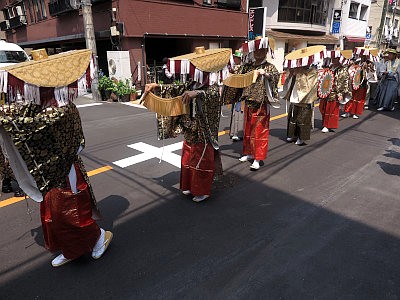

At 1pm, the dai-gyoretsu parade starts proceeding from here [MAP]. The procession ends at around 2pm when it reaches Asakusa Shrine.
From 2:20pm and 3:00pm, Binzasara-mai are performed in the shrine precincts. The Binzasara-mai is a kind of dengaku dance, which emerged from rice planting ceremonies about a thousand years ago.
At 3:30pm, shrine priests start filling about 100 mikoshi (portable shrines) owned by 44 local communnity entities of the Asakusa district with the spirits of the three divinities enshrined at Asakusa Shrine. Unlike Buddhism, Shintoism is not an idol worshipping religion - usually deities are thought to be purely spiritual beings and doesn't have a solid entity - so you can divide the spirits of gods as many as you like just by chanting while waving a branch of sakaki (a sacred spiecies of tree.) The deities enshrined at Asakusa Shrine are the guardians of the Asakusa district. The three mikoshi owned by Asakusa Shrine themselves have already been filled with these spirits since Thursday.
Day 2 : May 19 (Sat)
- 10:00am Ceremony
- 12:00am Procession of communities' mikoshi
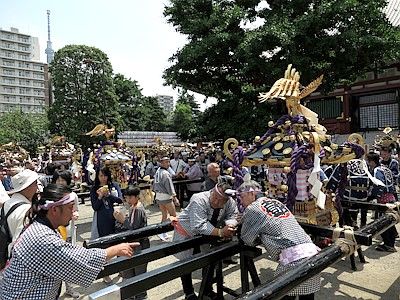

The about-a-hundred mikoshi owned by local communities show up and gather behind the main hall of Sensoji Temple toward noon.


From 12:00am, these mikoshi go into the shrine precincts one by one to pay respect to the shrine and then head for their own communities.
Day 3 : May 20 (Sun)
- 6:00am Miyadashi

These three are the mikoshi possessed by Asakusa Shrine and are larger than communities' mikoshi. Their names are Ichinomiya, Ninomiya, and Sannomiya, which means the first shrine, the second shrine, and the third shrine, respectively.


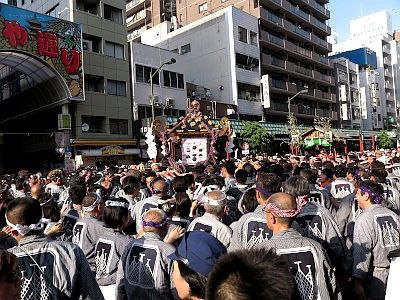
The highlight of the whole festival is said to be the miyadashi at 6am on Sunday. The miyadashi is the process of mikoshi getting out of the shrine grounds at the beggining of its procession. (But it will be extremely crowded, so I've never bothered to try and see one since I wasn't sure if I could see it all right.) If you're considering seeing it, it could get a little rough (fights might erupt) so if you have little kids with you, I don't recommend it.
Each mikoshi procession takes a route different from each other when parading through the town of Asakusa, which is the area the divinities protect spiritually. This way, the residents greet their spiritual guardians at their community, and the divinities purify their land. The parades go on all day until around 7pm, and the process of mikoshi entering the shrine precincts to end their journey is another highlight called the miyairi, though not as prominent as the miyadashi. After getting back to the shrine, the spirits which have been carried on the mikoshi are put back to the main shrine building, and this marks the end of the three-day-long festival.
Other things on the day

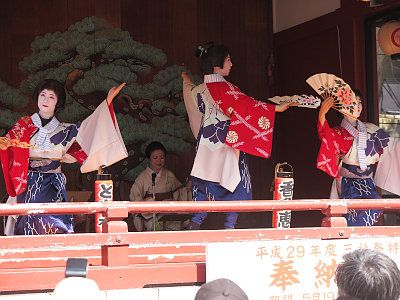


The main road in front of the Kaminari-mon gate will be pedestrians-only, and many communities' own mikoshi conduct their procession.
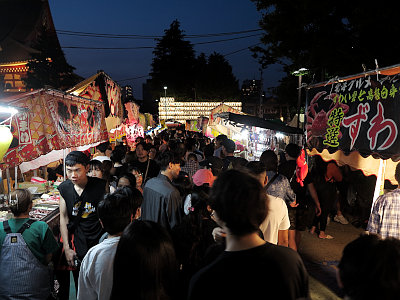
Many stalls serving fodds will be setup.

Drum performances will also be held here and there.
Area guide around this siteArticle on Asakusa Shrine